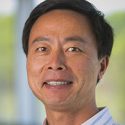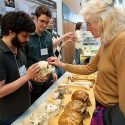Historic gift will drive research innovation
The largest individual gift ever to benefit UW–Madison – $50 million from alumni John and Tashia Morgridge – will pave the way for pioneering scientific collaboration at the Wisconsin Institutes for Discovery.
The Morgridge donation will be matched by the Wisconsin Alumni Research Foundation (WARF), together providing a $100 million boost to the building project, which will bring together scientists from a broad spectrum of disciplines to attack the problems of disease, advance regenerative medicine and solve other important problems.
“The Morgridges’ generosity has triggered a public-private partnership that will enable us to probe the convergence of various sciences and make the kinds of discoveries needed to protect human health and expand scientific knowledge,” says Chancellor John D. Wiley.
The gifts from the Morgridges and WARF, along with a state contribution of $50 million advocated by Gov. Jim Doyle and approved by the State Building Commission, will help make possible two institutes – one private and one public – on the 1300 block of University Avenue.
“We hope to extend the Wisconsin Idea, spurring new discovery, new treatments, new knowledge and new jobs,” says John Morgridge, chair of the board of Cisco Systems. “We think the possibilities are boundless.”
Tashia Morgridge, a retired special-education teacher, underscored the importance of the facility for Wisconsin students, from grade school through graduate school. “This will be a center for innovative teaching and learning, where university students will work not only in research teams, but with K-12 students in special outreach programs that will help grow tomorrow’s scientists,” she says.
The private institute, to be called the Morgridge Institute for Research, will encourage collaboration with industry and enable the institute to respond more quickly to capitalize on scientific opportunities as they arise.
The public institute will serve the campus community as a source of cutting-edge research and technology, and provide another venue for breaking down walls between disciplines and finding creative new ways to attack scientific problems.
The advances produced by these twin research institutes will also boost Wisconsin’s economy by creating new products and technologies, startup firms and good paying jobs, says Doyle, who unveiled the concept for the facility in November 2004.
“We must harness the power of discovery to build a knowledge-based economy and continue to be a leader in the growing biotechnology industry,” the governor says. “The Morgridges’ gift allows us to do that, while enhancing Wisconsin’s capacity for scientific research in a world-class facility.”
Doyle and Wiley say the facility will also help Wisconsin compete for and retain top-quality researchers and maintain its leadership in fields such as biotechnology, engineering, biology, nanotechnology and computer science.
Carl Gulbrandsen, WARF’s managing director, notes that the gifts are contingent on the State Building Commission approving a land swap between WARF and UW–Madison, and on the naming of WARF as the project developer. The proposal comes to the commission on April 19.
“The Morgridge Institute for Research will encourage even closer collaboration with industry, spur revenue-producing new inventions, and enable us to react quickly and capitalize on scientific opportunities as they arise,” Gulbrandsen says. “But the public and private sides will work together seamlessly to further our scientific and educational agenda.”
Wiley and the governor emphasize that the institutes will not operate in a vacuum. In addition to reaching out to industry, the institutes will specialize in basic research that will provide relevant discoveries to the Interdisciplinary Complex, now under construction adjacent to UW Hospital and Clinics, providing a smooth transition from discovery to development to clinical trials.
“UW-Madison has ranked in the top three for competitive federal research grants for the past five years, and the institutes give us a powerful tool to maintain that leadership well into the future,” Wiley notes.
The facility, similar to the Clark Center for Biomedical Engineering and Sciences at Stanford University, will be a hub of interdisciplinary work. For example, it is envisioned that engineers will work with biologists, microbiologists with nanotechnologists, computer experts with stem-cell scientists, and so forth.
The scope of the problems that the institutes will address means that the university cannot wait for a building to be constructed for the vital research to start. Beginning today, research proposals are being solicited, with seed money provided, to enable collaborative research to begin well before the institutes’ doors open.
“These collaborations need to begin, so that we can move into the facility with the momentum we need to make life-altering discoveries and groundbreaking scientific linkages,” Wiley says.



